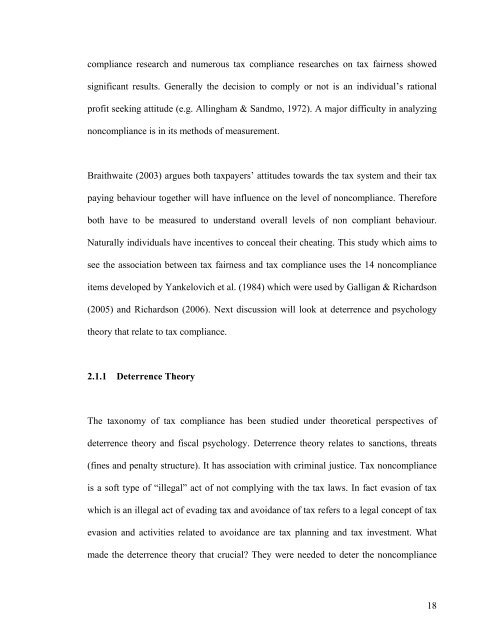1 CHAPTER 1: INTRODUCTION 1.0 Chapter ... - DSpace@UM
1 CHAPTER 1: INTRODUCTION 1.0 Chapter ... - DSpace@UM
1 CHAPTER 1: INTRODUCTION 1.0 Chapter ... - DSpace@UM
You also want an ePaper? Increase the reach of your titles
YUMPU automatically turns print PDFs into web optimized ePapers that Google loves.
compliance research and numerous tax compliance researches on tax fairness showedsignificant results. Generally the decision to comply or not is an individual’s rationalprofit seeking attitude (e.g. Allingham & Sandmo, 1972). A major difficulty in analyzingnoncompliance is in its methods of measurement.Braithwaite (2003) argues both taxpayers’ attitudes towards the tax system and their taxpaying behaviour together will have influence on the level of noncompliance. Thereforeboth have to be measured to understand overall levels of non compliant behaviour.Naturally individuals have incentives to conceal their cheating. This study which aims tosee the association between tax fairness and tax compliance uses the 14 noncomplianceitems developed by Yankelovich et al. (1984) which were used by Galligan & Richardson(2005) and Richardson (2006). Next discussion will look at deterrence and psychologytheory that relate to tax compliance.2.1.1 Deterrence TheoryThe taxonomy of tax compliance has been studied under theoretical perspectives ofdeterrence theory and fiscal psychology. Deterrence theory relates to sanctions, threats(fines and penalty structure). It has association with criminal justice. Tax noncomplianceis a soft type of “illegal” act of not complying with the tax laws. In fact evasion of taxwhich is an illegal act of evading tax and avoidance of tax refers to a legal concept of taxevasion and activities related to avoidance are tax planning and tax investment. Whatmade the deterrence theory that crucial? They were needed to deter the noncompliance18
















